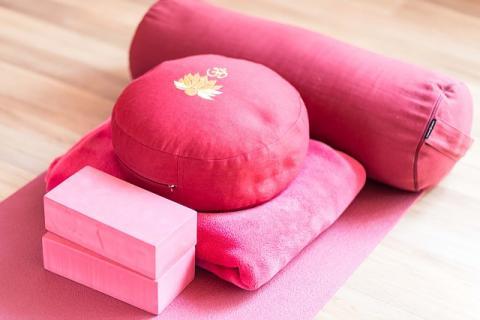
If you have ever joined yoga classes, chances are you are familiar with the whole jingbang of yoga props. From yoga blocks to mats, straps to bolsters, and of course, the ever-present yoga mats. Most of these accessories are also a bit dear on the pocket, especially if color, design, or eco-friendliness enters the picture.
However, small apartments, a shoestring budget or even a vacation means that these props may not be with us even though yoga still is. So what do we do then? We offer you some practical substitutes for those props – things lying about in the house or even at the hotel you have checked into that can be pretty good alternatives to those yoga props. So get your daily dose of exercise in your kind of yoga, and you don’t have to buy or lug the props around either…Read on, and get creative with yoga.
Yoga Blocks
The purpose of yoga blocks is to provide a little height whenever needed by becoming an extension of your body – typically 9 inches in length, 5 inches in width, and 3 inches in height – different brands may differ on the dimensions a tad. You would use these yoga blocks to support seated poses like the Sukhasana (easy pose) or even the Trikonasana (triangle pose) where your hand may not necessarily be able to touch the floor.
For seated poses, you can use really firm cushions, non-slip folded blankets or even a stack of books wrapped in a towel. For the standing poses, anything from a sturdy cardboard box, a non-breakable jar or a stack of tied up books will do.
Yoga Straps
Yoga straps are nothing but belts of cloth that help you go deeper in a stretch pose by letting you use your body’s weight and the earth’s gravity against yourself. Think of the Gomukhasana (cow face pose) where your hands may not easily touch each other or even the Utthita Hasta Padangusthasana (extended hand to lifted big toe pose) where the extended leg may end up bending because your hand doesn’t quite reach it.
If you don’t have a yoga strap around, a regular belt, tie, sock, scarf or even a sturdy rope will do the trick. Just make sure the fabric can take the stretch and not tear and cause you an injury.
Yoga Bolsters
Bolsters are the norm in restorative yoga asanas or classes and are used to support passive and reclining postures such as the Supta Virasana (reclining hero pose) or Savasana (the corpse pose) – with props, the emphasis can move from straining to actual healing.
To make a bolster substitute, lay two pillows on a towel side by side and then roll up the towel to form a sausage shape. You can also roll up a longitudinally folded blanket and then tie it up with rope. Oh, and any old yoga mat rolled up and tied up with a string is automatically a good bolster as well.
Yoga Cushions
Yoga cushions or meditation cushions are small circular pillows used to support your bottom in comfort as you go deeper into meditation. Frankly, any pillow will do the trick, and you can even make yourself a DIY yoga cushion by filling up a cushion case with old sweaters and mufflers – ensure there are no lumps before you sit for that 30-minute marathon meditation session.
Yoga Mats
Yoga mats are as as breathing for all yogis. However, if you are traveling or have just set that mat out to dry, you don’t have to skip the yoga class.
Practice your yoga on a non-skid carpet or carpeted flooring, or simply use a bedside rug with non-slip padding. Finally, when all fails, use a slightly damp towel laid out on the floor – the dampness will make it relatively non-slip.
Above all, remember that yoga is not a practice meant to strain, sprain or stress you. Go slow and let your muscles fluidly move into an asana – if it hurts, you are doing it much too soon, much too fast. Breathe and become part of yoga in slow and steady movements. Namaste!








